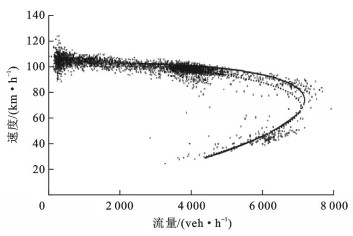Speed-density relation model of congested traffic flow under minimum safety distance constraint
Article Text (Baidu Translation)
-
摘要: 根据交通拥挤状态下交通流速度与密度一致性变化的特点, 分析了拥挤交通流的平均车间时距为定值的原因, 并结合最小安全间距约束提出了交通拥挤状态下的速度-密度关系模型。研究了驾驶人的平均反应时间和交通拥挤状态下的最小车间时距的关系, 对速度-密度关系模型的反应时间进行参数标定。分析了不同车辆长度、阻塞停车间距和反应时间下的速度-密度关系, 利用提出的速度-密度关系模型、Greenshields模型、Greenberg模型、Underwood模型、Northwest模型、Edie模型对美国US-101、I-80两条高速公路的交通数据进行拟合, 得到了拟合结果和绝对误差。分析结果表明: 提出的速度-密度关系模型能够从理论上解释交通拥挤状态下速度与密度的变化关系和速度-密度数据的离散现象; 和其他模型相比, 提出的速度-密度关系模型在拟合2条高速公路交通数据时的绝对误差最小, 分别为4.91、7.50veh·km-1。基于最小安全间距约束的速度-密度模型刻画了拥挤交通流的本质特征, 且对现实数据能够取得更好的拟合效果。Abstract: Based on the conforming change characteristic of speed and density for traffic flow under traffic congestion state, the reason that the average headway-distance of congested traffic flow was a fixed value was analyzed, and the speed-density relation model under traffic congestion state was put out combined with minimum safety distance constraint.The relation between the average reaction time of driver and the minimum headway-distance under traffic congestion state was discussed, and the parameter calibration of reaction time for speed-density relation model was carried out.The speed-density relations with different vehicle lengths, blocking parking distances and reaction times were analyzed, the traffic data of US-101 Highway and I-80 Highway in America were fitted by using the proposed speed-density relation model, Greenshields model, Greenberg model, Underwood model, Northwest model and Edie model respectively, and thefitting results and absolute errors were obtained.Analysis result shows that by using the proposed speed-density relation model, the change relation of speed and density under traffic congestion state can be explained in theory, and the discrete phenomena of speed-density data can be described.Compared with the other models, the absolute errors of fitting results for US-101 Highway and I-80 Highway are minimum by using the proposed speed-density relation model, and are 4.91, 7.50veh·km-1 respectively.So the proposed speed-density relation model based on minimum safety distance constrain reveals the substantive characteristic of congested traffic flow, and the fitting effect on actual data is better.
-
Key words:
- traffic planning /
- traffic flow /
- speed-density curve /
- congested condition /
- reaction time /
- minimum safety distance
-
表 1 模型参数
Table 1. Model parameters

-
[1] 张亚平, 张起森. 高速公路速度-流量模型研究[J]. 中国公路学报, 2000, 13(3): 73-77. doi: 10.3321/j.issn:1001-7372.2000.03.019ZHANG Ya-ping, ZHANG Qi-sen. A study of models of speed-flow for freeways[J]. China Journal of Highway and Transport, 2000, 13(3): 73-77. (in Chinese) doi: 10.3321/j.issn:1001-7372.2000.03.019 [2] 谭满春, 唐松安, 徐建闽. 多车道高速公路的动态离散交通流模型[J]. 中国公路学报, 2002, 15(2): 91-94. doi: 10.3321/j.issn:1001-7372.2002.02.023TAN Man-chun, TANG Song-an, XU Jian-min. Dynamic discrete traffic model of freeway with multiple lanes[J]. China Journal of Highway and Transport, 2002, 15(2): 91-94. (in Chinese) doi: 10.3321/j.issn:1001-7372.2002.02.023 [3] 何蜀燕, 关伟. 城市快速路交通流状态跃迁的实证分析[J]. 中国公路学报, 2008, 21(5): 81-86. doi: 10.3321/j.issn:1001-7372.2008.05.015HE Shu-yan, GUAN Wei. Empirical analysis of phase transitions of traffic flow at urban expressway[J]. China Journal of Highway and Transport, 2008, 21(5): 81-86. (in Chinese) doi: 10.3321/j.issn:1001-7372.2008.05.015 [4] 董春娇, 邵春福, 马壮林, 等. 阻塞流状态下城市快速路交通流时空特性[J]. 交通运输工程学报, 2012, 12(3): 73-79. doi: 10.3969/j.issn.1671-1637.2012.03.013DONG Chun-jiao, SHAO Chun-fu, MA Zhuang-lin, et al. Temporal-spacial characteristic of urban expressway under jam flow condition[J]. Journal of Traffic and Transportation Engineering, 2012, 12(3): 73-79. (in Chinese) doi: 10.3969/j.issn.1671-1637.2012.03.013 [5] LIGHTHILL M J, WHITHAM G B. On kinematic waves. Ⅱ: a theory of traffic flow on long crowded roads[J]. Proceedings of the Royal Society A: Mathematical, Physical and Engineering Sciences, 1955, 229(5): 317-345. [6] RICHARDS P I. Shock waves on the highway[J]. Operations Research, 1956, 4(1): 42-51. doi: 10.1287/opre.4.1.42 [7] GREENSHIELDS B D, BIBBINS J R, CHANNING W S, et al. A study in highway capacity[J]. Highway Research Board Proceedings, 1935, 14(1): 448-477. [8] GREENBERG H. An analysis of traffic flow[J]. Operations Research, 1959, 7(1): 79-85. doi: 10.1287/opre.7.1.79 [9] DRAKE J S, SCHOFER J L, MAY A D. A statistical analysis of speed-density hypotheses. in vehicular traffic science[C]∥TRB. TRB 45th Annual Meeting. Washington DC: TRB, 1967: 112-117. [10] PIPES L A. Car following models and the fundamental diagram of road traffic[J]. Transportation Research, 1967, 1(1): 21-29. doi: 10.1016/0041-1647(67)90092-5 [11] NEWELL G F. Nonlinear effects in the dynamics of car following[J]. Operations Research, 1961, 9(2): 209-229. doi: 10.1287/opre.9.2.209 [12] JAYAKRISHNAN A, TSAI W K, CHEN A. A dynamic traffic assignment model with traffic flow relationships[J]. Transportation Research Part C: Emerging Technologies, 1995, 3(1): 51-72. doi: 10.1016/0968-090X(94)00015-W [13] CASTILLO J M, BENITEZ F G. On the functional form of the speed-density relationship. I: general theory[J]. Transportation Research Part B: Methodological, 1995, 29(5): 373-389. doi: 10.1016/0191-2615(95)00008-2 [14] VAN AERDE M W. Single regime speed-flow-density relationship for congested and uncongested highways[C]∥TRB. TRB 74th Annual Meeting. Washington DC: TRB, 1995: 1-26. [15] MACNICHOLAS M J. A simple and pragmatic representation of traffic flow[C]∥TRB. 75 Years of the Fundamental Diagram for Traffic Flow Theory: Greenshields Symposium. Washington DC: TRB, 2008: 161-177. [16] WANG Hai-zhong, LI Jia, CHEN Qian-yong, et al. Logistic modeling of the equilibrium speed-density relationship[J]. Transportation Research Part A: Policy and Practice, 2011, 45(6): 554-566. doi: 10.1016/j.tra.2011.03.010 [17] VAN AERDE M, RAKHA H. Multivariate calibration of single regime speed-flow-density relationships[C]∥IEEE. Proceedings of the 6th Vehicle Navigation and Information Systems Conference. New York: IEEE, 1995: 334-341. [18] EDIE L C. Car-following and steady-state theory for noncongested traffic[J]. Operations Research, 1961, 9(1): 66-76. doi: 10.1287/opre.9.1.66 [19] SUN Lu, ZHOU Jie. Developing multi-regime speed-density relationships using cluster analysis[J]. Transportation Research Record, 2005(1934): 64-71. [20] BRILON W, LOHOFF J. Speed-flow models for freeways[J]. Procedia-Social and Behavioral Sciences, 2011, 16(2): 26-36. [21] HUANG Zhao-yi, CHEN Xiao-hong, LIN Hang-fei, et al. Movement nature of speed-flow relationship on congested expressway[J]. Journal of Transportation Engineering, 2008, 134(3): 137-145. doi: 10.1061/(ASCE)0733-947X(2008)134:3(137) [22] BANKS J H. Average time gaps in congested freeway flow[J]. Transportation Research Part A: Policy and Practice, 2003, 37(6): 539-554. doi: 10.1016/S0965-8564(03)00011-9 [23] GARTNER N, MESSER C J, RATHI A K. Traffic flow theory: a state of the art report[R]. Washington DC: Federal Highway Administration, 2001. [24] YEO H, SKABARDONIS A. Oversaturated freeway flow algorithm[R]. Berkeley: University of Californial-Berkeley, 2006. -





 下载:
下载:













